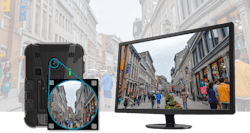This article originally appeared as the cover story in the August 2022 issue of Security Business magazine. When sharing, don’t forget to mention Security Business magazine on LinkedIn and @SecBusinessMag on Twitter.
Security businesses are ready to sell augmented safety, mobility and security to practitioners. End users have already purchased all solutions, but in verticals different than security: Intelligent Transportation Systems, Mobile Internet of Things AKA Vehicle to Everything (V2X), and Safety in Urban Areas.
Obstacles like public misperception of privacy loss and human replacement prevent some solution providers from Singapore, Israel, and India offering Western security dealers with extraordinary technology at a fraction of total cost of ownership, but as one market leader in Edge AI put it, “the acceptance through education of benefits is inevitable.”
Adding products and services for these markets is easier than you may think, once the seller understands what is possible by embracing new technologies:
Better surveillance: This can be achieved through a suite of sensors – instead of via just visible light – with 3D imaging, Time of Flight (ToF), radar, LiDAR, thermal imaging, temperature, and acoustics combining to form a common sensor fusion suite.
Edge AI: IoT is not just about video surveillance. Urban area and corporate management leverage machine learning, computer vision, intelligent noise reduction, energy wave analysis for vehicle crashes, ballistic detection, pollution/carcinogen detection, and more.
It should also be noted that there may be better ways to organize and use Edge AI data than Video Management Systems, and that purchasing most devices from a single source manufacturer may limit system agility and scalability.
In a sense, these technology purchases will inevitably be made – the question is, who will offer them first: security integrator or transportation solution provider.
Before an integrator offers a retrofit project to a city or corporate manager, turning one’s perspective inside out can deliver far lower TCO; in fact, instead of a legacy upgrade approach, consider leveraging mature tech that puts the intelligence where it already is – in a transit or security vehicle or physically on a person.
Transportation as the Gateway to Smart City Security
The argument can be made that adding sensors to a moving object adds complexities, such as resolving a now faster moving person carrying a weapon; however, sensor suites, processing and related neural networks on vehicles are mature, awaiting stationary systems to catch up and achieve Vehicle to everything (V2X).
Automated Driver Assistance Systems (ADAS) are under far greater scrutiny by the National Highway Traffic Safety Administration, much like fire and life safety systems are managed closely by authorities having jurisdiction. The ADAS market is growing fast, at an estimated 25.4% annual rate; thus rocketing sensor fusion and AI acceleration tech into the intelligent city, transportation, security and safety markets.
Although this is most prominent in the Asia/Pacific region, privacy constraints and the integrator channel may be the only impediments to similar growth in the Americas. The bonus is power, with battery technology advances permitting mobile or wireless surveillance cameras with computer vision, as well as all the aforementioned sensors.
Transportation and security administrators alike must think of where they want to apply their budget, or simply make an interim purchase for Edge AI devices, as these end-users are less constrained by capital physical and Information and Communications Technology (ICT) infrastructure budgeting.
Case in Point: When used with sensors on a vehicle MooVita – a partner of the Hailo AI inference processor – can sweep an entrie business district looking for fallen pedestrians, cyclists, vehicles associated with silver or amber alerts, and even active shooters if necessary.
Since these platforms are embedded, a corporation or city manager has the option to integrate data acquisition into legacy VMS – directly into a transportation, mass transit, rail control or fusion center, or even just through Mobile Messaging Platforms.
Body-Worn Becomes an AI Mobility Platform
Non-vehicle applications of AI are often body worn, or sometimes robot applications.
In Nov. 2021, Immervision announced its ultra-wide lenses would be integrated into the Percept body camera from IONODES. The collaboration gives physical security workers a body camera that can capture in real-time potential security threats in high resolution with“In the physical security industry, the challenge that most companies face with body worn cameras is that the video fails to effectively capture what’s occurring due to narrow field-of-view and poor image resolution,” IONODES President Eric Tasso said in a press release.
Added Pascale Nini, President and CEO at Immervision: “We look forward to continuing to make more innovative strides in developing high-quality wearable camera devices and AI-based vision systems.”
A security systems integrator exploring partnerships with companies like Immervision and IONODES will find technology partners that are not only familiar security industry leaders, but SoC, software, sensor and semiconductor companies that excel in city, safety, transportation and mobility verticals.
Driven by user experience and by these Edge AI-ready tech leaders, security and transportation practitioners will soon be demanding a cinematic 16:9 to 21:9 experience that eliminates lost FoV or pixels on the top, bottom or corners of the video.
Intersection Safety
In Monitoring Control Traffic (MTC), intersection safety and collision mitigation are the most complex visual and acoustic sensing and prediction scenarios. The fixed “traffic cam” is being replaced by products with 2-8 sensors, leveraging the processing power and efficiency of neural networks – and creating an opportunity for today’s smart city security systems integrator.According to a Federal Highway Research Institute of Germany study, thermal imaging is the most reliable detection alternative to inductive loops used in signal control technologies – helping to detect vulnerable road users like pedestrians and cyclists in or near complex intersections. As security integrators know, thermal means detection in complete darkness, adverse weather, high contrast and literally baking in an urban asphalt oven.
Teledyne FLIR’s Traficam AI and TRAFISENSE2 are ways for integrators to break into the smart city vertical by leveraging product expertise.
Under the Hood: AI Stream Processors
Consider a small city or large corporation with a few hundred IP cameras streaming to an Emergency Operations Center (EOC). Thanks to advances in AI-base video stream processing, a systems integrator can offer an upgrade with analytics such as pose (skeletal) detection, weapons detection, vehicle identification, face matching, instance detection, occupancy (with privacy), and multiple object behaviors. Another popular request is real-time image subtraction, redaction, mosaic or blur that follows a person, face, vehicle or object for privacy compliance purposes.
An AI Processor Unit with AI Acceleration Module, such as the Hailo-8 M.2, performs a continuous 26 tera-operations per second (TOPS) and is capable of processing 15 UHD streams from existing IP Cameras at very low power.
The use of an AI Processor Unit closer to a “natural” aggregation point of 10-15 existing IP video cameras permits the economical connection to another branch of fiber infrastructure serving a redundant command center in a smart city, transportation network or corporate campus. Infrastructure outages near either aggregation points would not result in service interruption as the AI Processor Unit is powerful enough to stream to multiple decoding locations; and consolidating AI stream processing to a 15:1 ratio drastically reduces cost per channel to purchase and operate.
Now consider scaling this “Computer Vision City” supported by a non-GPU PCI card like the Lanner Electronics Falcon H8 configurable with 4-6 Hailo-8 AI processors. What would this cost to deploy? Surprisingly, the cost would be approximately the same as a high-end IP PTZ camera.
This model is expected to dominate machine and server integration for virtually anything involving sensors and sensor fusion – supplanting the GPU at a lower cost per channel and far higher performance per power usage.
Skilled security solution providers can create this system with components that self-manage thermal load, running cool and fast. The alternative with a poor deployment of complex neural networks in life safety is unthinkable: Run hot, fail fast. But in the end, security businesses that recognize the importance of augmenting their customer’s operation for success will have an awesome opportunity in the Embedded Vision Ecosystem.
About the Author

Steve Surfaro
Steve Surfaro
Steve Surfaro is Chairman of the Public Safety Working Group for the Security Industry Association (SIA) and has more than 30 years of security industry experience. He is a subject matter expert in smart cities and buildings, cybersecurity, forensic video, data science, command center design and first responder technologies. Follow him on Twitter, @stevesurf.



